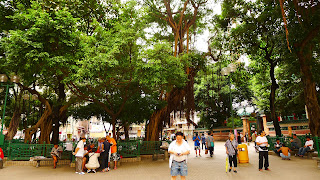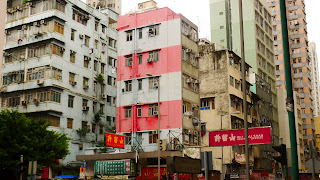Temple street (廟街) in Yau Ma Tei is well-known to tourists, but thankfully hasn't been overwhelmed by their visits, managing to retain a strong local presence and character. It resembles Tung Choi Street/Ladies' Street in Mong Kok; except Temple Street is also known as Men's Street. Which isn't to say that the merchandise of these street markets are limited by its gendered name. Ladies' Street does have a mountain of handbags (no guarantees on the authenticity of such goods. I must say that they aren't as blatant with their knockoffs now as they were then), but also offers fruit, electronic items, cell phone accessories, beach towels, stuffed animals, etc. And while Temple Street focuses more on male clothing, you'll still find stalls that sells pretty much everything in between. The enterprising mind won't be limited by geography...
Another notable difference between Ladies' Street and Temple Street is that the latter area provides a gathering ground for many of the city's elderly. Particularly Yung Shue Tau (榕樹頭), a public square at the heart of Temple Street, named for the banian (banyan) fig trees situated within. During the day it is frequented by ah baks sitting together for a conversation or a game of chess. In the evenings, the fortune tellers and other vendors emerge to cater to a bigger, and more diverse, crowd. Unlike the rest of Temple Street, it provides a stage for Cantonese Opera street shows, and live singers...(funnily enough, live singers are also taking to the streets on Sai Yeung Choi Street South in Mong Kok, just next to Ladies' Street/Tung Choi Street. Another parallel between the Ladies' and Men Streets?)
Judging from the Tin Hau temple there (the namesake of Temple Street), you can discern that the Yung Shue Tau area has a fishing-based heritage. The area has a long history, probably back when the Qing dynasty was still in control of China. I'll guess that the boundaries of this public square wasn't as well defined back then as it is today; the major roads (Shanghai Street, Public Square Street, etc.) currently surrounding the square didn't emerge until the mid-to-late 20th century, and now limits the possibility for spatial expansion. Photos below, with some lengthily captions:
 |
| Old people socializing; who needs facebook when you can talk face-to-face? (And no, facetime does not count) |
 |
| Buildings spotted around the area; this corner house is an old fashioned restaurant, famous for its retro fittings |
Trivia! You won't find the area by typing its name into googlemaps (the closest it'll take you is to Ngau Tau, off Lamma Island.) Yung Shue Tau is a name used amongst locals, so if you ask around they will know how to give directions there. You can also find it where Shanghai Street intersects with Public Square Street.
-----------------------
The street is the favourite seedy place of our imaginations in Hong Kong. Some of us were told not to venture to Temple Street alone during our childhoods, which fuelled the perception of dodgy happenings in that area. (It isn't as though Ladies' Street is crime-free, but it just feels as though the crimes committed there lack the gravity of those at Temple Street. Maybe Ladies' Streets seems more 'open' and 'approachable' because it is better connected to the main transport links...) The rumours about gang extortion of money from Temple Street vendors didn't help (hey, even Hong Kong films made Temple Street look like the romping grounds for gangs), nor did the evenings news a couple of years back featuring the street as the site of an acid attack 'from the sky' (someone threw a jar of acid from one of the many high rise flats in the area.) Sex toy stalls made the area look almost like the red-light district of Amsterdam, albeit the Hong Kong version looking more disorderly (and without the overt displays by prostitutes.) And then several months ago, during a dinner conversation, I overheard a story about these sex toys being sold-then-resold to unwary customers...without being cleaned in between transactions. Probably a fabrication, but this is the stuff urban myths are made of.






No comments:
Post a Comment